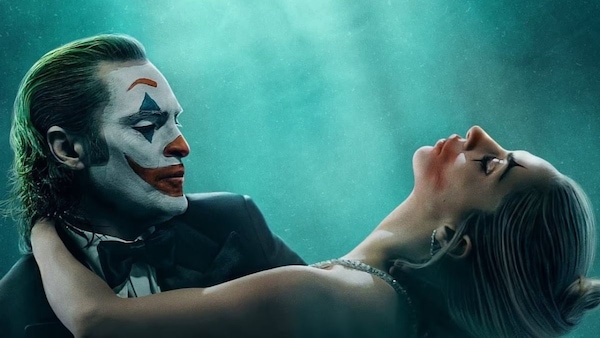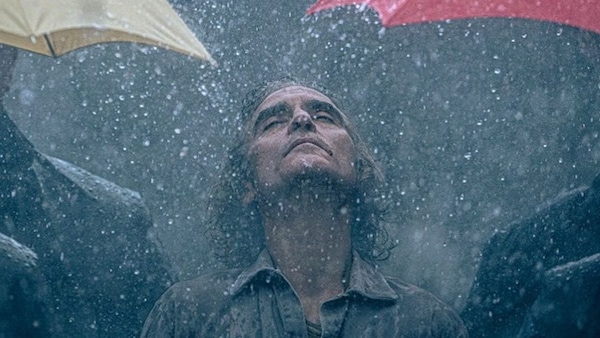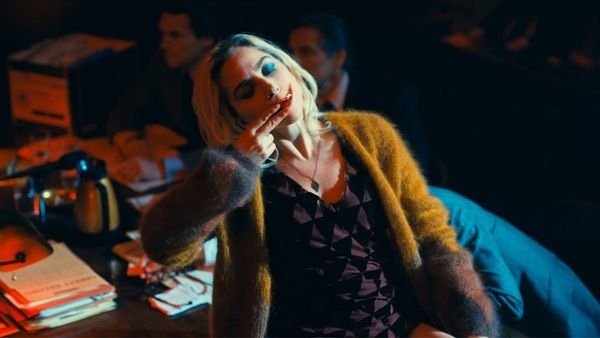Joker: Folie à Deux — Uneasy Lies The Head That Wears A Clown
In a desperate attempt to impress the audience, the film loses track of its identity. Its conflict is that it hopes to entertain our perception of the Joker, the beloved “Clown Prince of Crime”.

Promo poster for Joker: Folie à Deux.
Last Updated: 08.08 PM, Oct 02, 2024
HE'S SULLEN AND LOST. The burden of societal expectations weighs him down; his reputation threatens to swallow him. He is popular on the outside but lonely on the inside. And then he meets her. Something about her inspires him to be reckless and crazy again. It puts the smile back on his face. He can be whoever he wants, however he wants. She believes that this face paint is indistinguishable from his face. She is convinced that it’s his most authentic self — the one that inspires and arouses her. She needs him to be this version because it humanises her own fantasies; it validates all her dangerous impulses. She is determined to share his delusions. But he’s not so sure. He can’t tell the mask from the skin anymore.
That’s the plot of Imtiaz Ali’s Tamasha (2015), a musical love story between a troubled Indian man and his true identity. It’s also the plot of Todd Phillips' Joker sequel, titled Joker: Folie à Deux, a musical love story between a troubled American psychopath and his true self. In both cases, a girl catalyses the clash between reality and fiction. In both cases, it’s hard to tell which one wins.
Two years after being institutionalised, Arthur Fleck (Joaquin Phoenix) has lost his edge. He’s stopped telling jokes to the prison guards. He is…behaving. His body is shrivelled and bony — like a snake shedding flesh instead of skin — and he looks nothing like the psychopathic clown who shot dead a talk show host on live television. Fleck has a lawyer, Maryanne (Catherine Keener), who believes that his alter-ego, the Joker, is a product of multiple personality disorder. She sets out to prove that Joker is a performance borne out of childhood trauma and mental illness. That his medications are now working.

When Fleck comes across a young inmate named Harleen ‘Lee’ Quinzel (Lady Gaga), she sparks something in him. Like any man in love, he strives to be the hero she admires. Lee idolises the Joker: “I felt seen,” she admits describing his actions on the talk show. She falls for the reluctant symbol rather than the rehabilitating loner. She tries to tease the dormant clown out of him. When they have sex, she brings her make-up kit, yearning to be ravaged by the maniacal clown who shook the foundations of Gotham City. When his case goes to trial, the courtroom drama unfolds like a battle between the two voices in his head. The state prosecutors, led by young DA Harvey Dent, sketch him as a remorseless and theatrical killer — which is, ironically, the image that Lee and Gotham’s rebels worship.
Fleck buys into their love and tries to make a mockery of the case. He wants to lose, almost as if it will dispel his doubts about who he is. But every time Maryanne defends him and speaks of his abusive childhood, Fleck’s face darkens. His conviction cracks a little, and he wonders if he’s just another nutjob who enjoys the infamy. She uses science to explain his art. He does have a past: Is Joker simply his way to escape it? At one point, Lee looks heartbroken — and so disappointed — when Fleck shows a moment of ‘weakness’; when he dares to sound sensible. Which is to say that Joker: Folie à Deux is centred on an identity crisis. Fleck doesn’t know whether he’s acting or being anymore. Theoretically, it’s the perfect path to take for a sequel: ambitious, clever, moving. It’s a psychological thriller, in the sense that its suspense revolves around the psyche of the film. Several elements raise the question: Is this really the supervillain origin story we think it is?

But the problem is that this genre-suspense devolves into its own identity crisis. The opening paragraph of this review can apply to the film itself. It’s so weighed down by the burden of expectation that it behaves a lot like Arthur Fleck — narcissistic, strange, confused, often consumed by the looming contours of legacy. The ‘Lee’ in this situation is us, the audience. The film is so desperate to impress and be loved by us that it loses track of who it really is. Its conflict is that it hopes to entertain our perception of the Joker, the beloved “Clown Prince of Crime”. But it struggles, because that’s not its authentic self. The film knows that we are waiting for Fleck to go berserk — to slash, shoot or slaughter someone — again. It knows that we’re anticipating an inevitable explosion. The intent to craft a film out of this anticipation and anticlimax is correct, but the execution is not. It sometimes resembles a dog chasing cars. It just does things, because madness is often perceived as the complete lack of method.
The decision to be a musical — where Fleck and Lee break into fantasy songs (including ‘Get Happy’ and ‘That’s Life’) that reflect their moods and double up as imaginary dialogues between them — is an attention-seeking one. “Fleck discovers the music within him” is too thin a metaphor. Most of these duets seem to exist only to justify the presence of Lady Gaga, who is not so much an underwritten character as a thought blurb. One of the songs features Fleck, the hopeless romantic, dreaming of killing everyone in the courtroom to win her hand; it becomes the ultimate gesture of belonging. I get that it’s a subversive take on love being its own kind of delusion, but the film refuses to quit while it’s ahead. The music becomes a crutch, a bloated and flashy escape from the tragic psychosocial drama that Joker: Folie à Deux actually is. You can almost hear the director mutter “but they’re insane anyway” every time a song hijacks a moment.

At some level, though, the film’s identity crisis is also its profound strength. Arthur Fleck’s arc is a mirror image of the Batman-Bruce Wayne duality. Both characters are cursed by their ability to mean something more. Fleck’s Joker and Wayne’s Batman start off as reactive gimmicks to personal tragedies. They aren’t supposed to be saviours and symbols, but Gotham turns their private crusade into a public one. Unlike Wayne, who flirts with the courage to embrace the spectacle, Fleck crumbles under the cultural pressure of a sensationalist alter-ego. One might even say he succumbs to the courage of being himself. This hesitance is drawn out by another stunning and self-reflexive Joaquin Phoenix performance. It’s a role that unlocks the complex psyche of Fleck in a way that the movie cannot.
Read deeper into his quirks — like the way Fleck randomly breaks into his peels of laughter, even when he’s in tears — and the roadmap becomes clear. It’s the equivalent of an actor getting into character before a performance, or a superhero wearing his cape and hoping to magically fly. The manner of laughter signifies a forceful desire to harness the Joker from within; he spends most of the film searching for that monster. When he breaks into different accents in court, it’s not showy acting so much as Fleck fooling himself into Joker-ness for the sake of Lee and Gotham. When he smokes, sucking on a cigarette for all its worth, it’s like watching Fleck mimicking the swag and physicality that made the Joker famous. Imagine a madman striving to sell a medical condition as a performative conduit. There’s this constant tussle between playing a persona and trying to invoke him. Phoenix stages him as a man who swears by the devil within, only to be undone by the fragility of being human.

As a result, a potentially divisive twist at the end of the film works wonders. Phoenix’s freestyling of Arthur Fleck allows it to function as a callback to the opening scene — a Looney-Tunes-style cartoon starring the Joker at odds with his errant shadow. Only here, the shadow reveals itself as a sly shelter instead of an opaque silhouette. The twist not only casts the first film in a new light, but also upends the very notion of a Joker movie. After all, a shadow is also a natural imitation, and imitation — in a universe of dogs chasing cars — is the deadliest form of flattery. You don’t just do things; you do things better than those already doing them.
